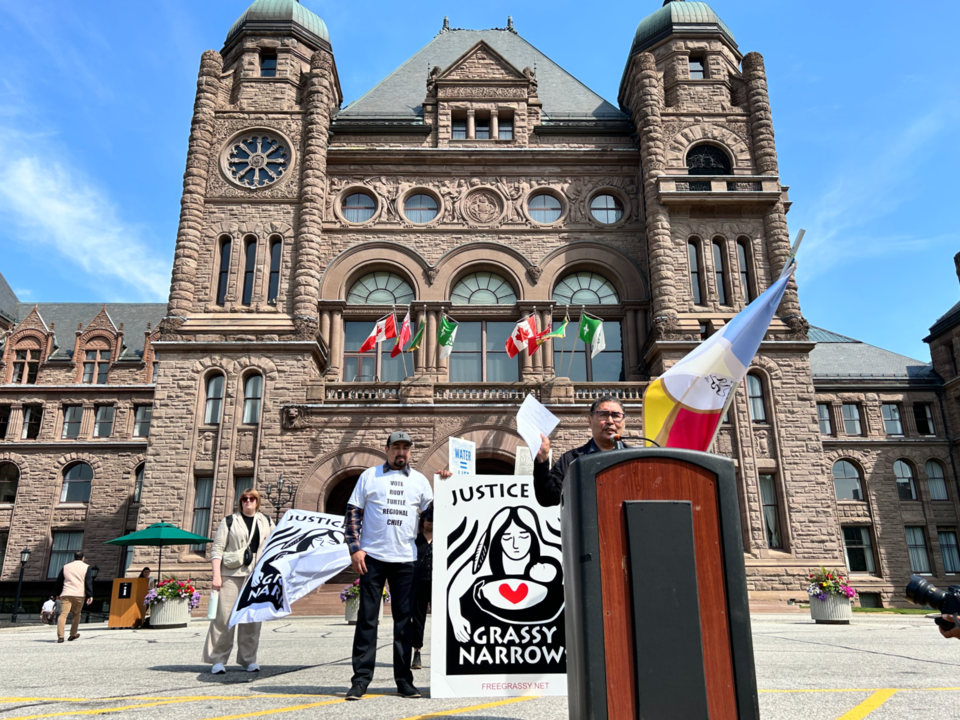This article quotes a source who describes a youth suicide.
Amnesty International is lending its voice in support of Grassy Narrows First Nation as it struggles with the ongoing effects of mercury contamination and pressures governments to do more — whether it be through the media or, recently, the courts.
The "urgent crisis" has roots more than half a century old, said Erin Riley-Oettl, the manager of human rights law campaigns and advocacy for Amnesty's Canadian section. She, along with representatives from Grassy Narrows and the federal government, spoke on Tuesday at a hearing at the Inter-American Commission on Human Rights.
She recapped for an international audience what many in Ontario already know: in the 1960s, Dryden Chemicals Ltd. dumped thousands of kilograms of mercury into the English-Wabigoon River, poisoning the fish and water flowing into Grassy Narrows.
Despite tens of millions in government funding and promises that the threat would dissipate over time, a recent report found that the Reed Paper mill's current emissions are exacerbating the impact of the mercury still in the water.
“Grassy Narrows went from self-sustaining to over 80 per cent unemployment overnight," Riley-Oettl said. “Over 50 years later, the fish consumption advisories remain in place, and Grassy Narrows' fish are among the most contaminated in Canada."
Mercury poisoning can cause tremors, walking issues, blindness and memory problems. Exposure during pregnancy can cause brain damage in the baby.
The community is doing the best it can — it trains members to be health-care workers and holds summer camps for youth — but many of its people are "very sick," Grassy Narrows Chief Rudy Turtle said.
“They have problems with their nervous system. Some people can't hold objects properly because they shake," he said. "And also, some people can't really walk properly."
Seeing no prospects, many have "lost hope" and simply stay at home, he said.
“What bothers me the most is the fact that the Canadian government knows what's going on. The provincial government knows what's going on. They have continually assured us that they're no longer dumping poison in our in our river system," he said. "But apparently, that's not true."
“It seems like Indigenous lives don't really matter when it comes to money.”
Judy Da Silva, Grassy Narrows' environmental health coordinator and a "mercury sufferer" herself, noted that the community lives an hour and a half from the nearest hospital and relies on air ambulance service and a clinic manned by nurses on weekdays.
“We do our best to fight this big monster that's poisoning us," she said.
Youth suicides, which have been linked to mercury poisoning, are a sensitive topic in Grassy Narrows because most people have been touched by one, Da Silva said.
Help just isn’t there for young people, she said. One teenager, she said, asked for medical help on a Friday and was told to to wait until Tuesday.
“She hung herself. She was only 17," she said.
Constantine Tikhonov, a manager with the Environmental Public Health Division of Indigenous Services Canada, spoke on behalf of Canada. He described the federal and provincial governments' funding and remediation efforts, including a community health facility that's currently being built, and almost $150 million for a mercury care home.
“Construction is anticipated to start this year and is estimated to last approximately two years. Indigenous Services Canada continues to work with community leadership as they take steps toward realizing their vision," he said.
Ontario has been working with the First Nation “to gather information about current contamination levels and sediments and fish in the river system and exploring management options for the remediation of these contaminants," Tikhonov added.
The care home is a "Band-Aid measure" that doesn't stop the active poisoning of Grassy Narrows residents, said Adrienne Telford, the First Nation's lawyer leading a lawsuit against Ontario and Canada. The suit alleges the governments are failing in their treaty responsibilities to allow Grassy Narrows residents to uphold their traditional way of life, which includes fishing.
“There isn't even an approved an approved remediation plan. It will be many years before cleanup of the river even begins," she said.
Turtle also turned his attention to mining, which, at the encouragement of the Ford government, is exploding in Ontario.
"We're being bombarded by mining activities. It's just unbelievable. It’s destroying our communities," he said.
Despite a 2018 declaration issued by Grassy Narrows demanding an end to logging and mining, about 5,000 mining claims have been approved in the area since then, Riley-Oettl said.
Ontario's Indigenous affairs minister and attorney general did not respond to a request for comment.
“You would think," Turtle said, "that by this time, especially after 50 years, that people's mindset would change, and we would start thinking about the environment, the long-term destruction that these practices are causing, and that we would start thinking about our future generation.”




